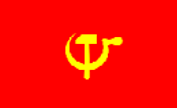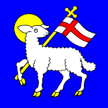- PAPAL CROSS
- The term that describes a cross with three horizontal arms crossing the vertical, and considered to represent
the Papacy – a triple-armed or triple cross (see also
‘cross 2)’,
‘cross of Lorraine’,
‘orthodox cross’ and
‘two and a half armed cross’).





Flag of Binn, Switzerland (fotw);
Arms and Flag of Križevci, Croatia (fotw); Arms and Flag of
Dolní Bečva, Czech Republic (fotw)
- PARADE FLAG (or PENNANT)
- 1) Generically, the term for any flag (or pennant) intended to be carried outdoors in a parade situation,
and made with appropriate materials and accessories - a marching flag/pennant.
- 2) Specifically, the term for that flag which is not a military colour as defined herein, but which is treated
and/or accessorized as such – for example those of the Royal British Legion (see also
‘colour 2)’,
‘cord(s) 1)’,
‘cravat 1)’,
‘fringe’,
‘tassels’,
‘sleeve 2)’,
‘staff’ 3)’ and
‘veterans flag’).
![[parade flag example]](../images/v/vxt-d2296.gif)
![[parade flag example]](../images/v/vxt-d1150.gif)
Parade Flag of the Royal Naval Association, UK (Graham Bartram); Parade Flag of the Royal British Legion, UK (Graham Bartram)
Notes
a) There are basically three ways
involving a sleeve by which a parade flag or military colour may be affixed to
its staff - with decorative nails (often a precisely regulated number of nails),
by means of a grommet and clip, or by tab and screw (see also
‘grommet’, 'nails'
‘sleeve 2)’ and
‘tab’) however:
b)
The practice of tying a colour/parade flag to its staff, or attaching it by cloth loops or metal rings
is still occasionally seen (see also ‘grommet’,
‘sleeve 2)’, 'tab'
and ‘ties’).
- PARLAY (or PARLEY) FLAG
- See ‘flag of truce’.
![[Flag of truce]](../images/v/vxt-d1170.gif)
- PARTI-COLOURED
- See ‘counterchanged’.
![[Parti-coloured example]](../images/v/vxt-d1176.gif)
Flag of Las Labores, Spain (fotw)
- PARTIALLY COVERING
- A term that may be used when a canton or other charge does not entirely cover one or more
of the stripes in a multi-striped flag – for example, a white disk partially covering the
centre two stripes on the national flag of Uganda as illustrated below (see also
‘covering’,
‘overall 1)’ and
‘multi-stripe’).
![[Partially covered example]](../images/v/vxt-d2019.gif)
![[Partially covered example]](../images/v/vxt-d1976.gif)
![[Parti-coloured example]](../images/v/vxt-d1977.gif)
Flag of Vista Alegre do Alto, Brazil (fotw);
Flag of Maranhăo, Brazil (fotw); National Flag of
Uganda (fotw)
Please note that this term is never used alone but always with the number of stripes
being covered and/or partially covered.
- PARTY
- The heraldic term that may be used when a shield or banner of arms is divided into two
horizontally, vertically or diagonally, or into four diagonally - see
‘per bend’, ‘per bend sinister’,
‘per fess’, ‘per pale’ and ‘per saltire’).
![[party example]](../images/v/vxt-d1368a.gif)
![[party example]](../images/v/vxt-d1368b.gif)
![[party example]](../images/v/vxt-d1368c.gif)
![[party example]](../images/v/vxt-d1368d.gif)
![[party example]](../images/v/vxt-d1368e.gif)
From left: Party Per Fess, Per Pale, Per Bend. Per Bend Sinister and Per Saltire
Please note that this term is never used alone, but always with the term describing the
direction of any such division, for example party per fess.
- PARTY FLAG
- See ‘political flag 1)’.

A Flag of the Communist Party, Iraq (Eugene Ipavec)
- PASCAL LAMB
- See ‘agnus dei’.

Flag of Bennwil, Switzerland (fotw)
- PASSANT
- See ‘Appendix V’.
![[passant]](../images/v/vxt-d1075.gif)
Example; Flag of Košařiska, Czech Republic (fotw)
- PASSANT GUARDANT (or PASSANT GARDANT)
- See ‘guardant’ and ‘passant’ in ‘Appendix V’.
![[passant guardant]](../images/v/vxt-d2813.gif)
![[passant guardant]](../images/v/vxt-d2814.gif)
Royal Standard of England 1198 – 1340 (fotw); Flag of
Häggenschwil, Switzerland (fotw)
- PATCHWORK FLAG
- 1) A flag or flag-like image that combines the national flags of those nations which
make up a supra-national entity or geographic area (see also
‘linguistic flags 1)’ and
‘supra-national flag’).
2) See ‘combined flag’.
![[patchwork flag]](../images/v/vxt-d1348.gif)
Example of a EU Patchwork Flag (fotw)
- PATRIARCHAL CROSS
- See ‘cross of Lorraine’.
![[cross of Lorraine]](../images/v/vxt-d1902.gif)
Flag of Ieper, Belgium (fotw)
- PATTÉE (PATÉE, PATTY or PATY) CROSS
- See ‘Appendix VIII’.
![[cross pattee]](../images/v/vxt-d1903.gif)
House flag of the Companhia Nacional de Navegaçăo Costeira, Brazil (fotw)
- PAVILION
- The heraldic term for an ermine-lined velvet robe of state that is draped
from a crown or coronet and framing a royal or princely coat of arms. If behind
a non-royal coat of arms it becomes a mantle (see also
‘armorial bearings’,
‘coat of arms’,
‘crown’, ‘ermine’,
‘mantle’
and and ‘royal arms’).
![[pavilion]](../images/v/vxt-d1652.gif)
![[pavilion]](../images/v/vxt-d2260.gif)
![[pavilion]](../images/v/vxt-d235.gif)
![[pavilion]](../images/v/vxt-d1495.gif)
Royal Arms of Egypt 1922 – 1953; Royal Arms of Sweden (fotw); Grand-Ducal Arms of Liechtenstein (fotw); Greater Arms of Serbia (Željko Heimer)
- PAVISADE
- A term for the practice, now obsolete, of showing a decorative display of shields along the sides of a ship
– see ‘deck flags’ (also ‘ancient 2)’,
‘crown of arms’, (also ‘postures’ and ‘streamer 2)’).
![[pavisade]](../images/v/vxt-d237.gif)
English Pavisade c1530 (CS)
Please note that the practice of hanging shields along the sides of a fighting
ship began as a defensive measure, but had become largely decorative by the mid-16th
Century.
- PAVON
- The medieval European term for a triangular flag or pennant whose lower edge was
at right angles to its staff, but which may be extended to include the increasingly
(but not entirely) obsolete oriental flag or pennant of this same pattern - see
‘dhvaja’ and ‘prayer flag’
(also ‘double pavon’).
![[China coast guard 1881]](../images/v/vxt-d238.gif)
![[Bartloming]](../images/v/vxt-d238a.gif)
![[Kiltai]](../images/v/vxt-d238b.gif)
![[Customs Service, China 1881]](../images/v/vxt-d238c.gif)
Flag of the Coast Guard, China 1881 (fotw); Flags of
Bartloming and
Kiltai, Indonesia
c1900 (fotw); Flag of the Customs Service, China 1881 (fotw)
Please note that the Editors have introduced an extension of this term, as no
accurate and/or established alternative could be found to cover the Oriental examples.
- PAYING OFF PENNANT
- In British RN usage and in some others the term for an extra long version of the standard masthead pennant; it is the tradition
in some navies that a ship on her final voyage, or at the end of an extended deployment
out of home waters, should fly a special pennant the length of which is commensurate
with the length of her last commission, or of the deployment being completed -
an action pennant, a homeward bound pennant or decommissioning pennant (see also
‘masthead pennant 1) & 2)’).
See supplemental note.
![[Paying off pennant]](../images/v/vxt-d1616.gif)





![[parade flag example]](../images/v/vxt-d2296.gif)
![[parade flag example]](../images/v/vxt-d1150.gif)
![[Parti-coloured example]](../images/v/vxt-d1176.gif)
![[Partially covered example]](../images/v/vxt-d2019.gif)
![[Partially covered example]](../images/v/vxt-d1976.gif)
![[Parti-coloured example]](../images/v/vxt-d1977.gif)
![[party example]](../images/v/vxt-d1368a.gif)
![[party example]](../images/v/vxt-d1368b.gif)
![[party example]](../images/v/vxt-d1368c.gif)
![[party example]](../images/v/vxt-d1368d.gif)
![[party example]](../images/v/vxt-d1368e.gif)

![[passant]](../images/v/vxt-d1075.gif)
![[passant guardant]](../images/v/vxt-d2813.gif)
![[passant guardant]](../images/v/vxt-d2814.gif)
![[patchwork flag]](../images/v/vxt-d1348.gif)
![[cross of Lorraine]](../images/v/vxt-d1902.gif)
![[cross pattee]](../images/v/vxt-d1903.gif)
![[pavilion]](../images/v/vxt-d1652.gif)
![[pavilion]](../images/v/vxt-d2260.gif)
![[pavilion]](../images/v/vxt-d235.gif)
![[pavilion]](../images/v/vxt-d1495.gif)
![[China coast guard 1881]](../images/v/vxt-d238.gif)
![[Bartloming]](../images/v/vxt-d238a.gif)
![[Kiltai]](../images/v/vxt-d238b.gif)
![[Customs Service, China 1881]](../images/v/vxt-d238c.gif)

![[Flag of truce]](../images/v/vxt-d1170.gif)

![[pavisade]](../images/v/vxt-d237.gif)
![[Paying off pennant]](../images/v/vxt-d1616.gif)